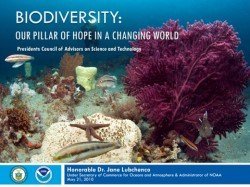Dr. Jane Lubchenco Presents to the President’s Council of Advisors on Science and Technology

Dr. Jane Lubchenco, Under Secretary of Commerce for Oceans and Atmosphere and NOAA Administrator, discussed the connection between biodiversity and ecosystem management in regards to the National Oceanographic and Atmospheric Administration’s responsibilities at the President’s Council of Advisors on Science and Technology (PCAST) meeting on May 21st .
PCAST welcomed Dr. Jane Lubchenco to talk about biodiversity and NOAA’s role, the need to cooperate across agencies, and the importance of international engagement on this topic.
Dr. Lubchenco’s briefing focused on discussing biodiversity’s key role in terms of its functional aspects, how it relates to the provision of our life support systems for the planet, what this means in terms of resilience of ecosystems and continued provision of critical services. Throughout her presentation, Dr. Lubchenco also called attention to the existence of a strong connectedness between biological diversity and national security, in addition to human health and the ability for humans and ecosystems to be resilient in the face of climate change.
The definition of “biodiversity” involves more than just identifying species and characterizing how many are out there, Dr. Lubchenco explained, as it also entails the understanding of how the genetic, habitat and species diversity are connected to the ecosystem’s functional aspects.
Another key concept addressed by Dr. Lubchenco was “resilience” of ecosystems. She defined resilience as, “the capacity of the system to absorb disturbance, to absorb change, to retain basic functioning despite disturbance, despite changes or to return to the basic functioning once it has been disturbed”. The changes that she referred to included: natural changes, storms, hurricanes, fires, floods, and also amphogenic changes, ocean acidification, climate change, and pollution, among others. Through video animation Lubchenco conveyed this concept in a visual manner and explained that, “the evidence suggests that systems that have a strong historic component of biodiversity that have not undergone significant losses of biological diversity are more resilient to a variety of perturbations.”
As a means to explain what we know about the connections between Biodiversity, ecosystem services and human well being, Lubchenco made reference during her presentation to the Millennium Ecosystem Assessment, an international scientific assessment of the state of knowledge of the environment published in 2005. She introduced the concept of ecosystem services, “the benefits that are provided to humans by virtue of the functioning of ecological systems.” She explained that by virtue of the interactions between the plants, animals and microbes with one another these are able to provide a series of benefits to human beings and other types of life on the planet.
At the Federal level, Dr. Lubchenco mentioned some example of the challenges NOAA is addressing such as: how to obtain and organize the knowledge, and develop a cohesive program that is not just obtaining the knowledge, but also uses that knowledge to inform policy and management, in addition to advancing understanding and awareness. These challenges are due to the insufficient coordination and cohesion within the Federal government addressing these gaps is essential.In terms of biodiversity, Dr. Lubchenco explained that NOAA is currently focusing on activities that preserve or restore habitats directly, with concentration on the functioning of the ecosystems that are involved. In addition, NOAA partners with other agencies in a suite of activities that focuses on improving and expanding available scientific understanding.
In regards to technology, Dr. Lubchenco touched briefly on some of the new ways its being used in regard to observing biodiversity. Satellite imagery can be used to better understand the state of ecosystems or to predict things like harmful algal blooms and to evaluate the amount of vegetation that might be stressed.
Finally, Dr. Lubchenco commented on the subject of the Ocean Policy Task Force and explained that NOAA is in the stage of finalizing recommendations to the President in hopes that these will be looked at in the near future. Dr. Lubchenco concluded saying that “there have been very significant advances in the science of Biodiversity, not just what’s out there, but what it does and how it relates to human well being. The time is right for a much stronger coordinated strategic effort on biodiversity and ecosystem services within the Federal agencies.”


